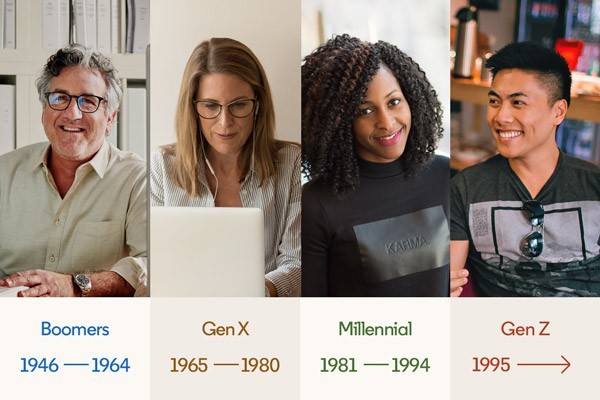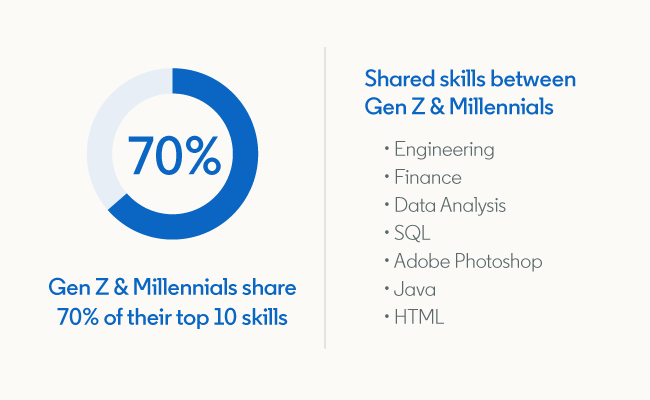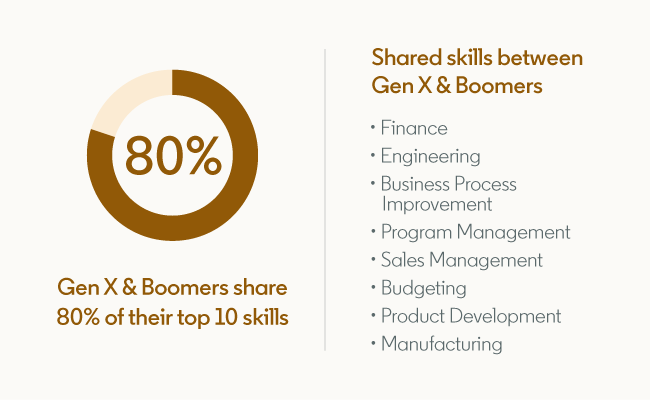New LinkedIn Data on Multi-generational Learning Reveals how to Drive Engagement
This year, Gen Z will be joining the workforce, bringing with them a brand new set of skills, backgrounds, and education. As a result, talent developers are faced with the challenge of engaging four generations—Gen Z, Millennials, Gen X, and Boomers—in learning at the same time.
To help understand multi generation learner engagement, we tapped into over 630 million LinkedIn members globally to better understand the capabilities they have, skills they need, and courses they’re taking.
Here is what talent developers should know:
1. All 4 generations of learners have more in common than you think
When it comes to multi-generational learners, we actually share a lot of skills and we’re interested in learning about some tried-and-true business topics. In the last year, all 4 generations shared 50% of their top ten courses, and the top course taken by all 4 generations on LinkedIn Learning was “Body Language for Leaders.”
As we dug deeper into LinkedIn’s skills data, we also found that the four generations could be paired into two groups—Gen Z and Millennials, and Gen X and Boomers—based on the similarities.
Gen Z and Millennials show a high proficiency in hard skills and technical skills. 50% of their top 10 skills were hard skills and 30% of their shared skills were focused on programming languages.
While Gen Z and Millennials bring a lot of necessary hard skills into their organizations, talent developers believe that they may be lacking some of the soft skills they’ll need to succeed. According to a LinkedIn study, 61% of talent developers said that Gen Z will need to strengthen their people skills more than developing their hard skills.
In contrast to the Gen Z and Millennial generations, these two generations lean more towards broader business skills. Talent developers can leverage the differences between these generations by appealing to each generation’s strengths and helping to fill some of their weaknesses.
2. We can use our differences to learn from one another
When we looked closely at the data about what skills each generation had, we found that the differences actually complimented each other very well. For example, Gen Z have strong tech skills, but lack some of the soft skills they need. Meanwhile, Boomers, who already have strong soft skills, are taking even more soft skills courses.
Top Ten Courses Taken by Boomers
It’s not hard to see how these two generations can learn from each other. Creating a bi-directional mentoring program is one way that talent developers can help cross-pollinate these skills from Boomers to Gen Z.
In return, the program could also allow Gen Z to explain the basics of the latest technical skills, so that Boomers have a baseline understanding of how these new technical skills might affect their organization.
Talent developers can also try recommending some of these foundational technology courses that are some of the most in-demand hard skills in 2019.
5 Intro Courses to the Top Hard Skills of 2019 |
3. Each generation is trying to fill unique skill gaps
Any seasoned talent developer knows that getting learners to engage is an ongoing challenge. One way to improve learner engagement may be by moving away from a one-size-fits-all strategy.
Our LinkedIn data revealed that the courses each generation is taking map to their unique career context. As Gen Z are starting their first jobs, for example, they’re trying to learn how to both obtain those jobs and perform well in those jobs once they get them. According to our Gen Z survey, 34% of Gen Z want to learn in order to impress their boss, but 23% are worried they won’t be able to do so. Gen Z want to learn how to make a good impression, with “Giving Your Elevator Pitch” and “Body Language for Leaders” among their top 10 courses.
Top 10 Courses Taken by Gen Z
Millennials are more seasoned in their jobs; however, a lot of millennials may be at an inflection point in their careers where they’re moving from individual contributors to managers. This may be why 8 out of the top 10 courses for Millennials were focused on job promotions or finding new jobs, as opposed to Gen Z whose courses were focused on performing well at their first job.
Most Gen X learners, on the other hand, are currently in leadership positions, so it’s no surprise that they’re most interested in improving as managers. Gen X learners are taking courses that help them hone their leadership and management skills, with 5 of their top 10 courses focused on topics such as “Body Language for Leaders,” “Project Management Foundations,” and “Developing Executive Presence.”
Boomers are the most seasoned generation in the workforce, but that doesn’t mean they believe they know it all. They do, however, believe in themselves more than other generations. While 56% of Boomers said that they currently have the skills necessary to make a career shift, even more impressively, 31% of those who don’t have the skills needed said they believe they can acquire the skills necessary to make a career leap. Boomers are more confident in being able to make a career move more than Gen X, Millennial, and Gen Z workers.
Next Steps
There is one common trend that spans all generations: the desire to develop and grow. With four generations now in the workforce, each with a unique set of skills and learning needs, talent developers have an incredible opportunity to make an impact in their organizations.
As talent developers focus more of their attention on closing skills gaps, they’ll want to leverage the different skills that already exist within their organizations. The good news is that many of the skills that exist between different generations actually complement each other very well. Talent developers can leverage these complementary skills, along with each generation’s unique motivations, to drive their businesses forward and boost learner engagement across the board.
If you want more learner engagement tools, tips, and templates, visit LinkedIn Learning’s Learner Engagement Playbook.
Methodology
We leveraged course and skills data, from Feb 2018-Feb 2019, from our 630+ million Linkedin members. We also include insights from numerous LinkedIn surveys, including the 2019 Workplace Learning Report, which surveyed 1,200 talent developers and 2,100 workplace learners globally.
Linkedin members were placed into generational categories based on the “implied” year they were born. For reference, the generational categories are:
Topics: Learning and development
Related articles








